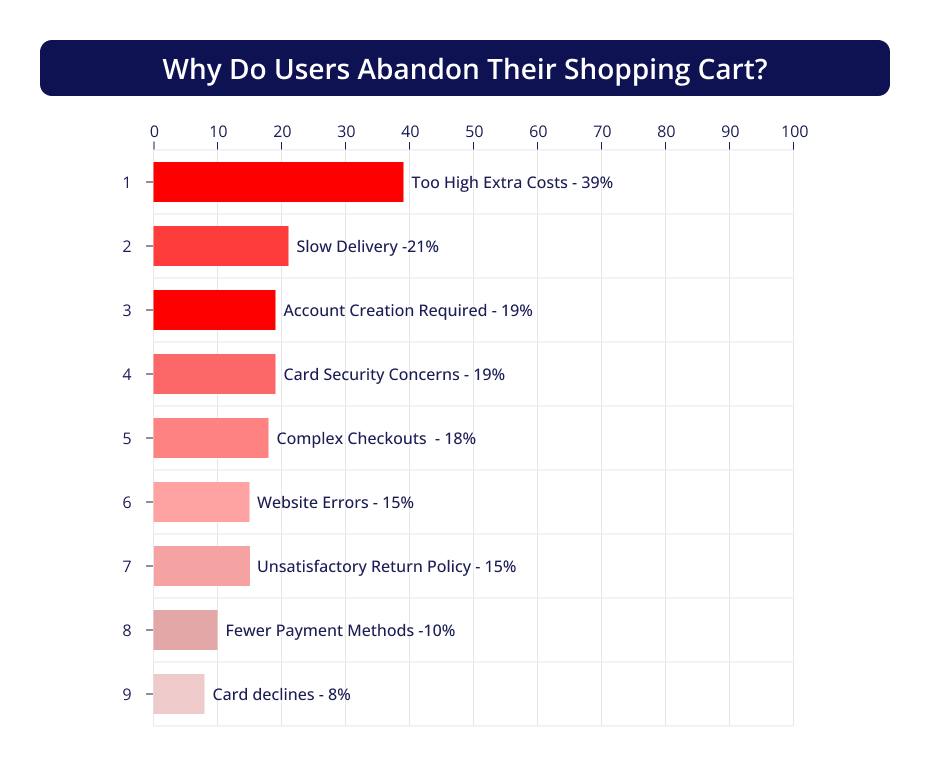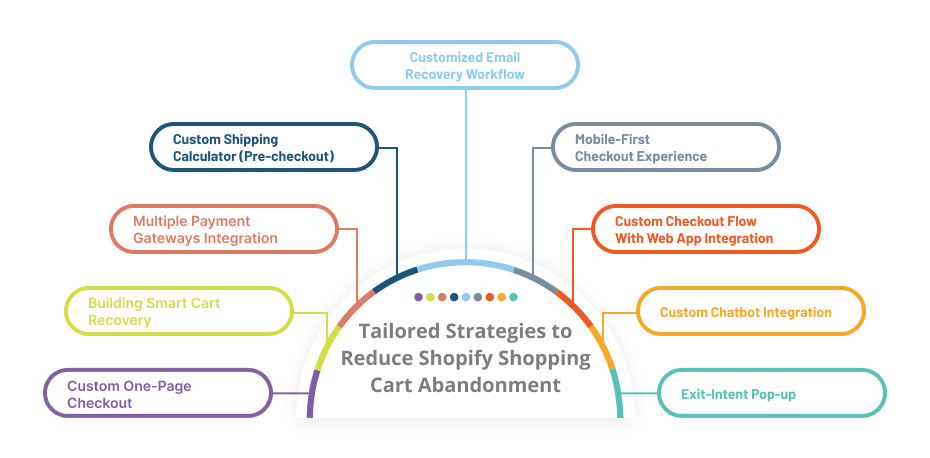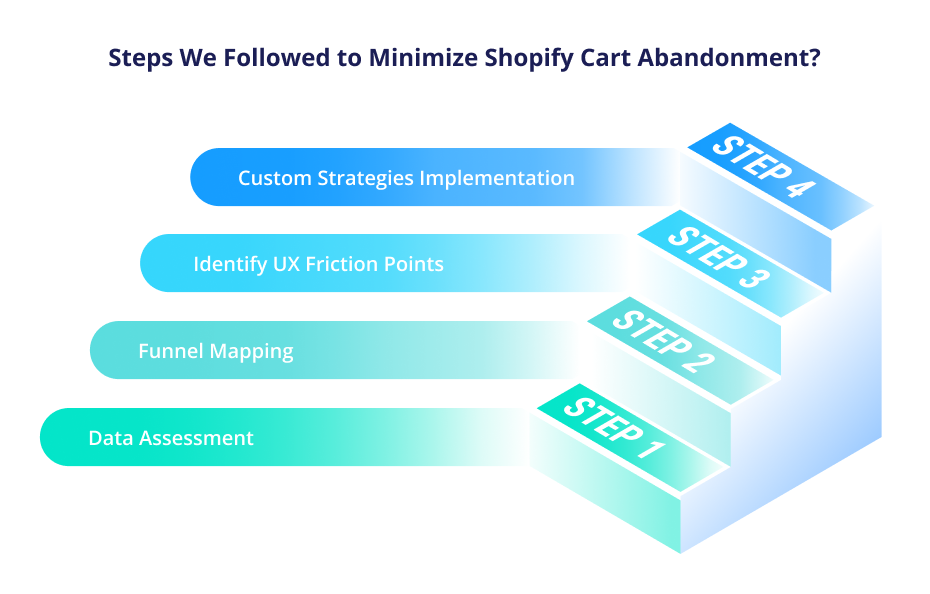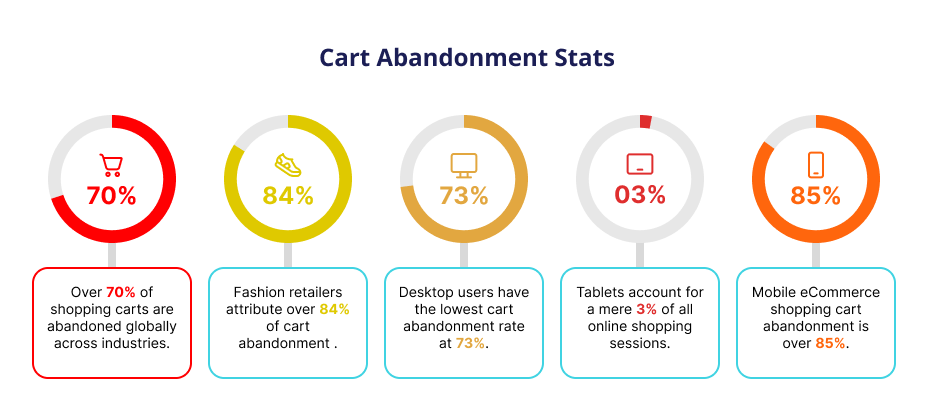- Understanding Shopify Cart Abandonment
- Statistical Overview on Cart Abandonment
- Custom Approach to Reduce Shopping Cart Abandonment on Shopify
- 1. Streamlining Checkout with Custom One-Page Flow
- 2. Building Smart Cart Recovery
- 3. Multiple Payment Gateways Integration
- 4. Custom Shipping Calculator (Pre-checkout)
- 5. Customized Email Recovery Workflow
- 6. Mobile-First Checkout Experience
- 7. Custom Checkout Flow With Web App Integration
- 8. Custom Chatbot Integration
- 9. Exit-Intent Pop-ups
- How We Minimized Shopify Cart Abandonment With Custom Development?
- Steps We Followed to Minimize Shopify Cart Abandonment?
- How Much Does it Cost to Reduce Shopify Cart Abandonment?
- Reduce Shopify Cart Abandonment Ratio by Partnering With CSSChopper
You might be surprised to know that 6 out of 8 users abandon an eCommerce site due to security or complex payment procedures. In fact, Bymard Institute’s study stated that 70.19% is the overall shopping cart abandonment rate. For an e-commerce business, watching its potential customers abandon their cart at the last time is painful. This is especially true with leading CMS stores, like Shopify, where increased Shopify cart abandonment became a bigger concern.
We have seen it firsthand. The increased number of abandoned carts has quietly reduced Shopify merchants’ conversion rates and overall revenue. This has been one of the store owners’ pain points, requiring a practical approach to turn the tide. However, the easier the path seems, the longer it will be.
We encountered similar challenges with our clients, who reached out to us to reduce shopping cart abandonment on Shopify. Find out how we assisted our clients with custom web development solutions and optimized their conversion rate.
Understanding Shopify Cart Abandonment
Shopify, a premier online store development platform, allows users to easily build and curate an e-commerce site. However, cart abandonment is a significant challenge for all e-commerce sites, including those hosted on Shopify. Users discard their orders when shopping online instead of placing them, which is categorized as cart abandonment, irrespective of the platform.
The reason behind the increasing Shopify cart abandonment ratio revolves around various factors, like:
- Complex checkout process
- Difficult navigation
- Insecure checkout page
- Poor mobile experience
- Unclear return and refund policies
These factors combined contributed to a higher checkout cart abandonment ratio. But, how to reduce shopping cart abandonment on Shopify? Merchants must understand that addressing these issues can significantly improve user satisfaction, sales, and loyalty.
What is the Average Shopify Cart Abandonment Ratio?
The average shopping cart abandonment rate typically ranges from 60% to 80%. This means that out of every 10 potential customers who add products to their carts, 6 to 8 of them abandon their shopping cart.
That’s a substantial amount of unrealized revenue a business loses due to increasing Shopify cart abandonment. This ratio can fluctuate based on factors like industry-specificity, region, or even similar store design.
How do you calculate Shopify Cart Abandonment Ratio?
Finding the “how” of shopping cart abandonment on Shopify is quintessential before pursuing further. One of the benefits of Shopify is that it automatically shows you the total ratio of carts discarded. But, what if you want to calculate it on your own by considering the analytics?
A simple cart abandonment rate formula that can aid you further:
Cart Abandonment Rate = (Number of Carts Abandoned/ Carts Curated)* 100
For instance, if 1000 visitors have added products to their shopping cart, and only 400 have made the purchase, the total Shopify cart abandonment is 600. Infusing this into the formula:
Cart Abandonment Rate = (600/ 1000)* 100 = 60%
Statistical Overview on Cart Abandonment
Cart abandonment is not a new phenomenon. Over the years, businesses dealing with specific products have faced this. Understanding the number behind the increasing checkout cart abandonment is crucial to setting the stage for actionable solutions. Here is a detailed analysis:
- Globally, over 70% of shopping carts have been abandoned across various industries.
- Retailers in the fashion industry have listed over 84% of the shocking cart abandonment ratio due to the increase in window or comparison shopping.
- Over 73% of desktop users abandon their carts (lowest compared to other devices).
- Tablet shopping makes up only 3% of the entire online shopping session.
- The highest of all the devices is mobile eCommerce shopping cart abandonment, over 85%.
Why Do Users Abandon Shopping Cart?
We investigate some crucial numbers, but we must also determine “why” users abandon the checkout process. Understanding this helps identify the pain points that deter customers from completing the purchase. Here are some reasons Bymard Institute’s study has advocated, including:
-
Too High Extra Costs
The study stated that around 39% of shoppers abandon their carts due to high costs, like shipping fees or taxes. This highlights why transparency is an essential factor to consider in online shopping.
-
Account Creation Required
Over 19% of users have discarded their cart when forced to create a specific account to complete the purchase. This suggests that many shoppers prefer a streamlined experience, and creating a different account hinders checkout.
-
Slow Delivery
Due to the slow delivery of products, 21% of shoppers have abandoned their carts. This reflects a growing expectation among users for quick and efficient service.
-
Card Security Concerns
19% of users faced concerns about their crucial card information security and have not completed their shopping. It showcases the critical need for eCommerce store owners to implement robust security measures.

-
Complex Checkouts
A complicated checkout process prevents users from purchasing an item, and over 18% of them did the same due to this. This indicates the importance of a user-friendly and intuitive checkout process.
-
Website Errors
A Shopify-based online store with technical issues can directly impact sales, as evidenced by the 15% of users who abandoned their carts. This highlights the importance of maintaining a reliable and efficient shopping experience.
-
Unsatisfactory Return Policy
15% of customers claimed that the return policy was unclear and was the reason behind their cart abandonment. This suggests that clear and customer-friendly return policies can enhance consumer confidence.
-
Fewer Payment Methods
10% of customers abandoned their carts due to fewer payment methods. This emphasizes the importance of offering multiple payment methods to cater to different customer preferences.
-
Card Declines
8% of users’ credit cards were declined, which is a prominent reason behind cart abandonment at checkout. This highlights the need for retailers to provide alternative payment solutions to accommodate customers facing such challenges.
Custom Approach to Reduce Shopping Cart Abandonment on Shopify
Off-the-shelf Shopify solutions won’t help reduce Shopify cart abandonment based on the above stats. Hence, looking for an experienced team to implement tailored solutions into your business process is wise. They will help you infuse custom web development strategies to improve your conversion rate. Here is a detailed breakdown:
1. Streamlining Checkout with Custom One-Page Flow
Multi-step checkouts are known friction points, leading to a higher number of shopping cart abandonments. A tailored approach can be applied by your hired team to reduce this friction point and curate a one-page checkout covering shipping, billing, and payment into a single dynamic interface.
Key Benefits of Custom One-Page Checkout:
- Real-time field validation and error handling
- Auto-filled fields for returning users
- Less cognitive load due to fewer clicks in the checkout process
2. Building Smart Cart Recovery
You must also focus on creating a smart cart recovery system that helps users remember what they have added to their cart (if they drop it by mistake). This system should work even when a user is logged out.
Features You Must Add to Reduce Shopping Cart Abandonment on Shopify
- The items a user added to their cart are saved through cookies or local storage
- Synchronization across devices for users who stay logged in on different devices
- Auto-opening of the cart after every visit by a user
3. Multiple Payment Gateways Integration
One primary reason for Shopify cart abandonment is not finding the preferred payment gateway to complete the purchase. Your hired Shopify developers can build a conditional logic that displays payment gateways to users based on their region.
Example of Payment Options to be Included to Avoid Shopify Cart Abandonment
- Apple Pay and PayPal for users based in the USA
- Klarna and Worldpay for users in the UK
- Razorpay for Indian customers

4. Custom Shipping Calculator (Pre-checkout)
How much does it cost to ship a particular product from one country to another? This is the foremost question users ask, and they leave the site because of the hidden shipping cost calculator. When you hire a custom eCommerce web development company, they will help you build a custom shopping estimator that directly appears on the product and cart pages.
As a custom eCommerce web development company, we created a custom shipping estimator that appears directly on the product and cart pages.
How does it work?
- This detects the location of users by detecting their IP addresses
- AI-inclusion helps assess cost based on the product’s weight and delivery zone.
- Our custom Shopify solution offers updates in real-time, irrespective of the device type.
5. Customized Email Recovery Workflow
Most companies built a three-time reminder system via email to encourage users to complete their purchases. However, a more effective approach can be built for one of the best eCommerce platforms, Shopify. A meticulously curated behavioral email workflow can leverage custom triggers based on various factors such as cart value, session length, and interaction history.
How does it add effectiveness in reducing Shopify Cart Abandonment?
- Within an hour of cart abandonment, a reminder email with the product’s visuals is sent to users
- After 24 hours, a follow-up email highlights the product’s scarcity with an exclusive discount.
- Finally, after 72 hours, a nudge that includes a FREE offer.
6. Mobile-First Checkout Experience
More than half a dozen traffic comes from mobile devices, and not aligning the site with these devices is an approach that requires further ado. Your hired team can re-engineer the checkout process to be mobile-friendly with clear instructions.
Things your hired team can apply to reduce cart abandonment on Shopify
- Addition of sticky checkout CTAs on product and cart pages
- Your hired Shopify team can include lazy loading to boost performance
- Focus on enlarging the input areas and payment buttons.
7. Custom Checkout Flow With Web App Integration
Customization can be elevated by integrating the checkout process with a lightweight Shopify-based progressive web application interface designed specifically for returning users.
How Does It Help Reduce Shopping Cart Abandonment?
- The integration was successful and enabled a quick load time via local cache.
- Personalized checkout steps based on past orders.
- Real-time shopping cart synchronization with the application’s backend.
8. Custom Chatbot Integration
You do not want your users to leave unanswered and abandon their carts because they did not receive customer service on time. Hence, you must work with a Shopify development company that can integrate AI chatbots into your Shopify store and provide answers to users in real-time.
How does a custom chatbot decrease cart abandonment?
- Deliver on-time answers to users’ specific shipping, returns, or payment queries.
- Helpful in applying promo codes during the purchase.
- Can escalate to live support if needed.
9. Exit-Intent Pop-ups
Pop-ups and their excessive usage on websites, especially e-commerce ones, are annoying and have become one of the compelling reasons to abandon checkout on Shopify. A custom approach towards this can aid you in improving your conversion rates.
How We Minimized Shopify Cart Abandonment With Custom Development?
One of our clients in the D2C industry, which sells Home Decor in the USA, experienced a significant increase in cart abandonment on Shopify. The cart abandonment ratio was around 70%, with most drop-offs occurring during the Shopify checkout process or right after the reveal of shipping costs.
Our Approach Towards Reducing Shopify Abandoned Checkout
Our team of top Shopify developers assessed our client’s online store and formulated a custom strategy to overcome this challenge. As an experienced custom web development company, we have curated custom Shopify solutions focused on reducing checkout friction at every stage, including:
- We replaced the default checkout page and infused a custom-built one-page checkout flow.
- Our team infused region-specific dynamic payment gateways into the Shopify store.
- To let users assess their shipping costs early, we custom-coded a shipping cost calculator and embedded it into the store.
- We built an intelligent abandoned cart recovery Shopify-specific email workflow.
- Based on the Shopify abandoned cart report, our team optimized the checkout process for mobile users.
- We further embedded a custom AI chatbot to recover abandoned carts and assist during high-intent interactions.
Our Shopify developers did everything to streamline the buying journey by reducing friction at critical touchpoints, which significantly improved cart recovery rates. As a result, this ultimately drives more conversions and revenues for the store.
Outcome After 90 Days
Here’s a brief on how we reduced abandoned carts on Shopify.
| Merit | Before Custom Development | After Implementation | Improvement |
| Shopify Cart Abandonment Rate | 70.05% | 50.5% | ↓ 30.2% |
| Mobile Checkout | 0.8s | 2.0% | ↑ 133% |
| Abandon Cart Recovery Mails | 2.5% conversion | 18% conversion | ↑6.5x |
Our AI-first Shopify team turned a struggling Shopify-based business into a conversion-fueled business, without relying on the installation of bulky third-party apps. The result was a faster, seamless, smarter, and more efficient checkout process.
Steps We Followed to Minimize Shopify Cart Abandonment?
We followed comprehensive steps and brainstorming sessions covering how to reduce checkout abandonment. Our team approached the problem like a strategist and implemented a precision-focused approach.
Step 1- Assess Data
We analyze the data to understand where, why, and how users drop the cart by digging deeper into the analytics, heatmaps, and session recordings.
- We assessed the cart abandonment rate across different devices.
- Our team analyzed Shopify cart abandonment by identifying high-exit pages and user drop-off stages.
- We segmented the cart drop-off based on user type (like guest vs logged-in).
Step 2- Funnel Mapping
Now that we have the data of our client’s store, we performed a comprehensive funnel mapping to visualize the entire purchase funnel. The insights we got included:
- We found the user drop-off at certain steps, including payment and shipping.
- Our team noticed a significant friction on mobile vs web
- We pinpointed those steps that are causing Shopify cart abandonment

Step 3- Identify UX Friction Points
After successfully evaluating funnel mapping, we audited every part to find the friction points of eCommerce shopping cart abandonment. Our findings include:
- Slow page loads on the mobile checkout process.
- No real-time shipping estimates.
- Irrelevant payment options, missing region-wise payment gateways
- Multi-step complex checkout increases Shopify cart abandonment
Step 4- Implement Strategies to Decrease Cart Abandonment
Once we assessed, evaluated, and identified points increasing cart abandonment on Shopify, we deployed a custom eCommerce web development strategy to aid our client. This includes:
- Formulation of custom pages with project-focused technologies
- Reducing multiple checkout pages to one.
- Including smart, custom-coded exit-intent pop-ups.
We took time to understand the friction points and created a strategy that covers a user-centric approach and delivers the maximum results as our client envisioned.
Step 5- Performance Monitoring
Our work didn’t stop at implementing strategies towards reducing Shopify cart abandonment. We further provided continuous support to our D2C client. Our AI-first Shopify experts closely monitor the performance of the online store and implement steps like:
- Tracking KPIs like cart abandonment, conversion rate, and checkout completion daily
- Perform A/B testing to further refine the customer experience
- Integrations based on real-time data and seasonal user behavior.
How Much Does it Cost to Reduce Shopify Cart Abandonment?
The cost of decreasing the abandoned cart ratio on Shopify depends on your approach. Whether you take a DIY approach or a custom-coded approach, the difference in cost will be evident. Since we followed a full custom-first approach to minimize the checkout page intervention, the table below will cover the cost:
| Scope | Estimated Cost Range |
| One-page custom checkout | $8,000 – $15,000+ |
| Custom shipping estimator | $4,000 – $10,000+ |
| Region-specific logic | $1,000 – $6,200+ |
| Abandon Cart recovery workflows | $5,000 – $11,500+ |
| AI Chatbot Integration | $5,000 – $15,000+ |
If you are expecting a significant 30% reduction in cart abandonment, then you must expect to invest between $20,000 – $35,000, or more, in custom web development services, as per your project.
Reduce Shopify Cart Abandonment Ratio by Partnering With CSSChopper
The increasing number of abandoned carts is a serious challenge to conquer. You do not have to face them alone. That’s where the right development partner makes all the difference. Partnering with a company with hands-on experience becomes a must. CSSChopper can assist you in overcoming this by infusing our years of experience. We engineer solutions tailored to clients’ specific needs.
Whether you deal in D2C, B2B, or B2C, our team’s strategy-first approach resolves the root issues of increasing Shopify cart abandonment. We build experiences that convert better, smarter, and faster. We have delivered various projects that cover cart abandonment-specific needs. Our AI-first team uses modern technologies to deliver impactful custom Shopify solutions.
So, are you Ready for Custom Shopify Development? Let CSSChopper transform your Shopify store into a conversion engine.
Categories
Recent Posts
Popular Posts
- How to Choose a Reliable Offshore Development Partner?
- Transforming Web Development with HTMX’s Declarative Approach for Dynamic UIs
- Why Your Conversion Funnel Needs a Composable Commerce Solution?
- How to Outsource Web Development in 2025: Complete Guide
- What are the Top Web Development Trends for 2025?





